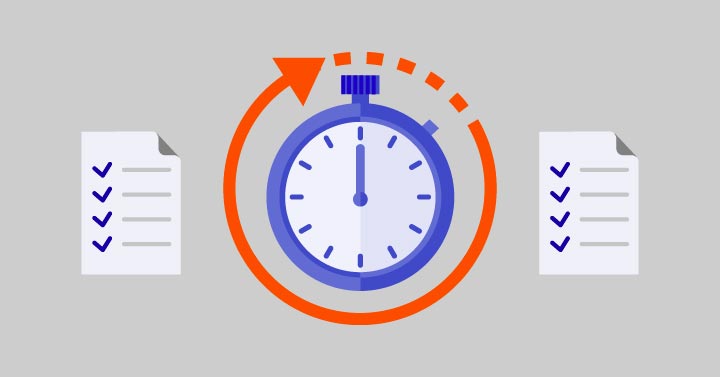What would be the impact to your team members and the success of your communication campaigns from a 300% improvement in your document review process?
This level of opportunity exists within many regulated communication programs—simply by adopting some basic principles for improving productivity.
Accelerate Your Document Review Process
Accelerating the document review process, while reducing the stress on team members can be achieved readily by focusing on the reduction or elimination of time spent:
- Searching for content
- Reviewing and inspecting low-risk content
- Redundantly reviewing repetitive content
- Participating in rework cycles
The means to reduce these forms of waste comprises of a combination of people, process, and technology.
Let’s start with understanding the opportunity.
Identify Waste in Your Process
The first step in improving your document review process efficiency is to clearly identify waste in your current process. There are a variety of approaches for identifying the specifics for your particular process such as value stream mapping, but for now we are focused on the expected outcomes, which break down to four main categories of activity:
01
Activity Blockers
02
Low Value Activity
03
Redundant Activity
04
Rework Activity
Activity Blockers
Activity Blockers prevent the completion of productive activities in any process. While working with many content authoring and review teams, we noticed that the most prevalent example of this is the time and effort associated with searching for content—and versions—associated with the authoring process. This may include locating specific pieces of standard text, existing assets for re-use, or identification of the most recent copy of document(s) for subsequent review, editing, or movement to production processing.
Clients focusing on technology and process—including strict standards—can eliminate these blockers and eliminate this wasted time.
Low Value Activity
Low value activities in the document review process generally comprise of either failure to filter out unnecessary work, or completing activities which should be automated. In the content editing and review process we still see team members reviewing vast amounts of boilerplate content in order to assess the accuracy of a smaller number of salient data points. In addition to consuming large amounts of time, review processes focused on large bodies of repetitive content are not suited to human processing and are prone to error. Technology and processes need to be adopted to support review and approval focused primarily on human verification of critical personalized data with automated verification of repetitive boilerplate content.
Redundant Activity
As a result of regulatory requirements, most communication campaigns—particularly in the health care space—require many different variants of content to meet the specific needs of individual segments of populations based upon those regulations. Authoring, editing, and reviewing of repetitive content is still proving to be resource intensive and wasteful for many communication teams.
Rework Activity
Requirements for large numbers of content rework cycles remains a major source of wasted time in the document review process. Each edit and review cycle carries the tax of completing the same activity multiple times (increasing the risk of human error), as well as the execution and tracking of that rework.
Cut Through the Clutter
By working through the four classes of challenges with numerous communications teams we have adopted some basic principles that have been shown to reduce the levels for each of the activities to a negligible amount. As in most cases, an effective solution requires proactive changes in people, processes and supporting technology. While we cover some basic areas of concern that often offer the lowest hanging fruit, a comprehensive improvement process should entail a formal process analysis, such as Value Stream Mapping that we recommend and execute for our larger clients. Short of that analysis the following points are a cheat sheet for improvement.
Activity Blockers
The most common activity blocker we see in document review processes is failure to access the correct version of the right information at the right time. This failure is typically due to:
- Use of Email for exchange of content versions
- Failure to establish a source of truth for digital assets and most importantly all versions
- Failure to establish formal naming and indexing standards
Key solutions to consider include:
- Implementation of a content management system, specifically with mandatory adoption of version management
- Implementation of naming and tagging standards for all digital assets (also assisting in version management)
- Training of all stakeholders for compliance with standards and tool usage
- Automated processing steps that mandate compliance with standards and/or make the standard effectively the ‘default’
Low Value Activity
Elimination of low value activity is a critical yet challenging step in cutting through the clutter. Consider the following challenges which prevail in many large numbers of organizations:
- Reviews of large bodies of standard content to verify smaller number of embedded key details
- Review of content for which there are very rare incidents of issues
- Review of content for which the issues are repetitive and can be classified
There is always opportunities to eliminate the majority, if not all human intervention with modern Natural Language Processing capabilities. Modern processing capabilities will help you extract key content for rapid or automated verification. These processes can perform automated validation or frequently machine-assisted validation, or adopt machine learning algorithms to improve automated identification of anomalies over time. Your content management selection identified above may in some cases provide the support, or alternatively third-party add-ins can provide the required automated processing. If adopting a new platform, consider adding these capabilities to the required feature list.
Redundant Activity
Regulated communications are typically loaded with requirements for content variations targeted at different audience segments, particularly within the health care sector. We still see many organizations burdened with the authoring of many versions of content that are very similar, but necessarily different to meet the needs of those different segments. Consider the following challenges that are faced by the teams within organizations dealing with this requirement:
- Authoring of standard or very similar content across multiple documents or templates
- Editing and revision of identical content across a body of documents
- Review and approval of identical content across a body of documents and across time
We recognize that well established technologies are in place to reduce or eliminate each of these activities. However, many communication teams are still in the process of fully utilizing tools to modularize frequently used content, managing bodies of documents or templates that leverage the content. This includes the review and approval processes critical for regulated customer communications programs. Adoption of one or more applications that manage content in a modular fashion to reduce the effort associated with managing highly versioned communication programs is a critical step to scaling modern communication programs. Modern communications teams should adopt technology platforms and processes that automate the full composition process from raw data elements through to final form documents.
Rework Activity
One of the most expensive forms of waste (from an efficiency perspective) associated with communication program management is rework activity or the effort to repeatedly edit, review, reject and return versions of content associated with programs. Rework also represents one of the biggest items that threatens time-based SLAs which are a never-ending challenge for communications teams. Consider the following process challenges that drive rework:
- Incomplete or poorly documented review cycle issues and feedback
- Incomplete or incorrect application of changes across a body of documents due to failures in issue tracking or resolution management
- Review process failures for large documents across multiple editing iterations
Mitigation of rework activity requires a combination of solutions including proofing automation, detailed issue collection and management, issue tracking and tools for automation across similar documents in a body of content.
Solving the Challenges
Addressing all of the challenges in your document review process can be a daunting challenge. The most important element of any process improvement strategy is to understand that the improvement process should include short term quick hits. At the same time, ensure you maintain a program of continuous improvement as regulations, business requirements, technology and team abilities evolve over time. Include the following elements in your strategy
Process Mapping and Analysis
Consider one of many industry methodologies for analyzing processes such as Value Stream Mapping; the first step should be to understand the scope of your processes and processing volumes. We recommend against a long, detailed analysis; keep the first iteration simple to identify the easiest low-risk opportunities. It is more effective to implement solutions for processing tracking and measurement to ensure validation of the impact of your process and technology changes.
Content Management Solution
Implementation of a content management solution for reliable tracking of all campaign assets is a mandatory starting point for any communications program. Complete a thorough analysis before making a selection and don’t assume the big industry names will cover all requirements. Ensure that near term or future integration of advanced capabilities especially process tracking and analysis as identified below are possible, affordable and available as ‘default’.
Process Tracking
Support for longer term process improvement will be contingent on understanding where your inefficiencies lie. Avoid complex tools that introduce more overhead than benefit—tracking should be a natural outcome of process activity.
Time Analysis
Base your hypotheses for improvement opportunities on fact; the challenges in process completion are often not where participants expect. Identify waste elimination opportunities that are big enough to make a difference—far too often we see time spent eliminated minor overhead. As obvious as it sounds, avoid spending time resolving minor waste contributors—regardless of how wasteful they may appear.
Iterate
The challenges within every process evolve over time so continue to iterate on your process improvements. We have clients who have been iterating for more than seven years, finding new opportunities for process improvement and streamlining every year as their team and environment constantly evolve.
Summary
Creating, reviewing and implementing documents for large-regulated communications programs is complex and prone to inefficiency due to activity blockers, redundant activity, low value activity and rework. Campaign management teams are challenged to find the time to address their challenges, but those which do have a significant upside based upon today’s technology options. Key components of any application stack include mature capabilities in:
- Content Management
- Version and Versioning Management
- Composition
- Workflow and Approval Management
- Quality Assurance Automation
- SLA Tracking and Reporting
Finding the right combination of solutions that cleanly integrate into a powerful engine for meeting your campaign objectives, is a critical step on the road to significantly increasing the speed of your content generation and document review process.



